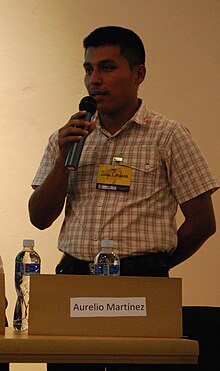Sumu (people)

Aurelio Martinez representing the Tawahka subgroup of the Sumo people in Honduras at a conference at the Universidad Nacional Autónoma de Honduras.
|
|
| Total population | |
|---|---|
| 10,000 | |
| Regions with significant populations | |
|
|
|
| Languages | |
| Panamahka, Twahka, Ulwa, Spanish, Miskito | |
| Religion | |
| Christianity | |
| Related ethnic groups | |
| Cacaopera Indians, Matagalpan Indians, Miskito, Garifuna |
The Mayangna (also known as Sumu or Sumo) are a people who live on the eastern coasts of Nicaragua and Honduras, an area commonly known as the Mosquito Coast. Their preferred autonym is Mayangna, as the name "Sumo" is a derogatory name historically used by the Miskito people. Their culture is closer to that of the indigenous peoples of Costa Rica, Panama, and Colombia than to the Mesoamerican cultures to the north. The Mayangna inhabited much of the Mosquito Coast in the 16th century. Since then, they have become more marginalized following the emergence of the Miskito as a regional power.
The Mayangna Indians, today divided into the Panamahka, Twahka and Ulwa ethno-linguistic subgroups, live primarily in remote settlements on the rivers Coco, Waspuk, Pispis and Bocay in north-eastern Nicaragua, as well as on the Patuca across the border in Honduras and far to the south along the Río Grande de Matagalpa. The isolation of these communities has allowed the Mayagna to preserve their language and culture away from the assimilatory impulses of both the larger Miskitu Indian group, who live closer to the Atlantic coastline, and the ‘Spaniards’ (as the Mayangna still refer to the Spanish-speaking Mestizos who form the ethnic majority population of Nicaragua), who are for the most part confined to the larger towns in the region that the Mayangna inhabit.
The evidence provided by an analysis of the Misumalpan language family, to which the Mayangna languages belong and which also includes Miskitu and the extinct Matagalpan and Cacaopera tongues once spoken in the Nicaraguan highlands and southern El Salvador, indicates the continuous presence of these groups in the region from around 2000BC. In fact, until the migration from southern Mexico of tribes speaking Oto-Manguean languages who arrived on the Pacific Coast of Nicaragua in the ninth century AD and the invasions of Nahuatl groups from even further north that followed, Misumalpan languages were probably spoken across the whole of Nicaragua.
...
Wikipedia
